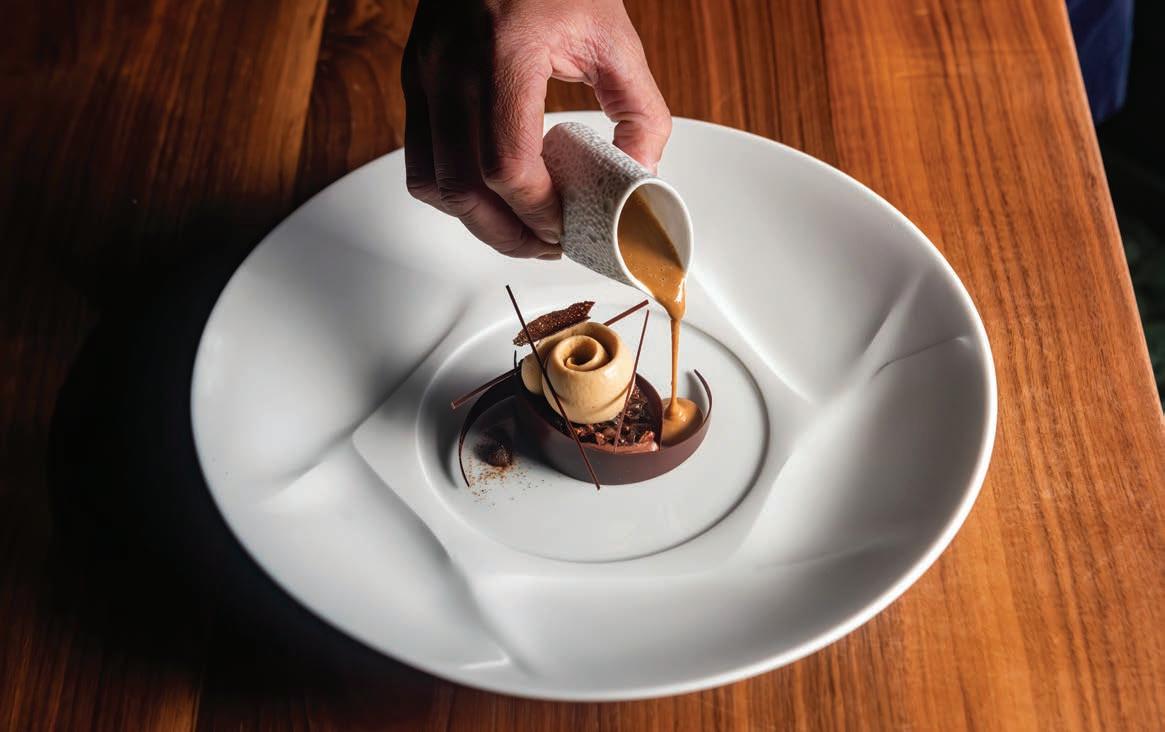
4 minute read
Cacao Crusader By ACF Chef Robert Wemischner
from National Culinary Review (January/February 2025)
by National Culinary Review (an American Culinary Federation publication)
CACAO CRUSADER
Chef Mac Daniel Dimla leads the charge in bean-to-bar chocolate at Providence
By ACF Chef Robert Wemischner
Chef Mac Daniel Dimla, executive pastry chef at the two-star Michelin restaurant Providence in Los Angeles, has become a wizard of bean-to-bar chocolate. Part Wonka, part mad scientist, he fully champions small cacao farmers who, in his words, are “super dedicated and deliver uniformly high-quality beans.”
His influence is everywhere in the restaurant, from signature sourdough bread and plated desserts to post-dinner friandises and take-home mini bars of Providence chocolate, given as parting gifts at the end of the tasting experience.

Chef Dimla, a 2014 graduate of the Culinary Institute of America at Greystone in California, honed his chocolatemaking craft in early 2020. “The pandemic’s silver lining, if there was any, was the time I got to spend exploring beanto-bar chocolate-making at home,” he says. “I was assessing batches and roasting beans from small cacao plantations in Hawaii and Peru, fueling my interest as a hobbyist and developing my palate for the tropical, acidic and exotic flavor notes in cacao. The dark chocolates we ended up making, through trial and error, contain 70 to 75% cacao solids and cocoa butter depending on their origin, with small amounts of dehydrated jaggery sugar for the dark chocolate and organic white sugar for the white chocolate.”
In the summer of 2021, when the restaurant reopened to limited diners, Chef Dimla eased into a manageable bean-to-bar program. It has since expanded significantly. The restaurant now brings in 55-pound bags of Hawaiian fermented cacao beans and 80 pounds a month from Peru, varying with menu needs and seasons. The beans, all grown sustainably, fuel chocolate production under the restaurant’s roof, near its second-floor garden, which provides herbs, edible flowers and honey for both sweet and savory creations. “This setup provides hyperlocal inspiration for the entire kitchen,” he says.
On a sunny LA day during a tour of the operation, Chef Dimla explained his chocolate philosophy. “It all starts with sourcing. We get cacao beans from growers I’ve visited and trust. Once sourced, it’s all about careful roasting, which we do in our ovens at controlled temperatures. This process brings out the tropical and acidic notes. From there, we winnow the roasted beans mechanically—before, it was done by hand—to remove the outer shells, which we use in our tisane, a delicate hot drink for guests.”
Making creative use of byproducts fits the restaurant’s ethos. “Producing food that is delicious and environmentally conscious— whether seafood, produce or cacao— is our goal,” Chef Dimla explains.

Controlling the production process allows the restaurant to present a specific flavor profile. “This is evident in everything we serve, from pre-desserts and main plated desserts to post-dinner confections,” he says.
Chef Dimla is also exploring new possibilities. “We’ve just gotten a machine for extracting oils,” he says. “It’s designed to press oils from seeds and nuts. Our goal is to make our own cocoa butter by crushing nibs to extract the fat. It’s a work in progress, and we’ll see if it’s cost-effective.”
Using chocolate soon after production is a priority. “This way, we retain the brightness and complexity of flavor,” Chef Dimla says. “I haven’t tried aging the bars yet, but it could lead to interesting results.”
Keeping the ingredient list short is another priority. “We don’t add vanilla to our dark chocolate,” he says. “I like the inherent flavors of cacao to shine through, minimally sweetened. For milk and white chocolates, we sometimes add powdered vanilla beans, but only sparingly to avoid masking the cacao’s complexity. Vanilla should be a whisper, not a shout.”
The chocolate dessert on the tasting menu showcases multiple textures: airy sponge cake, custardy cremeux, whipped ganache, cinnamon and hazelnut praline, smoked cream ice cream, delicate chocolate lace and a tableside pour of crème anglaise with espresso and Ceylon cinnamon. “This says late fall and winter to me,” Chef Dimla says.
It also says “delicious” to the 80 or 90 guests enjoying dinner, confident their every need will be anticipated by the skilled team in this long-running temple of gastronomy.



